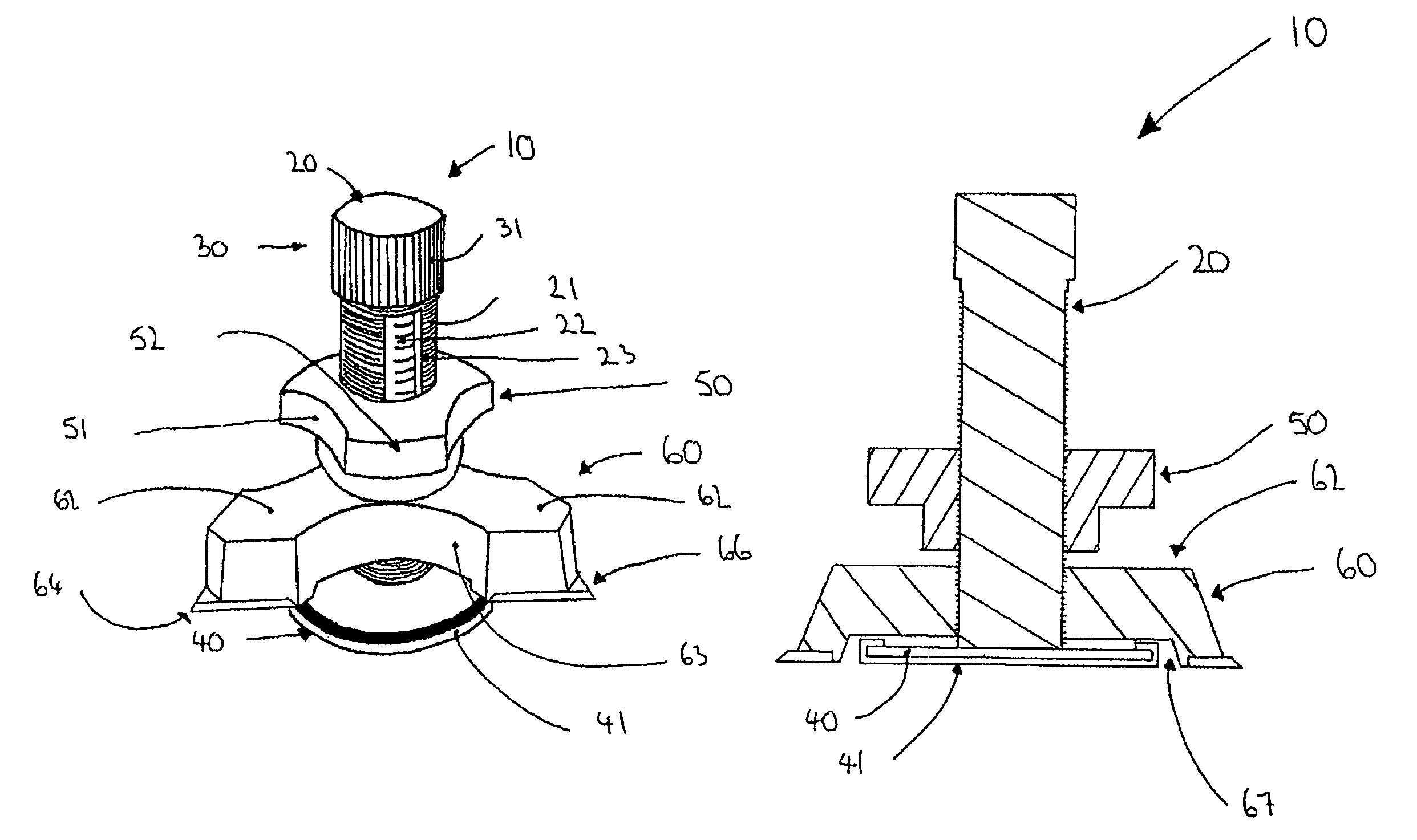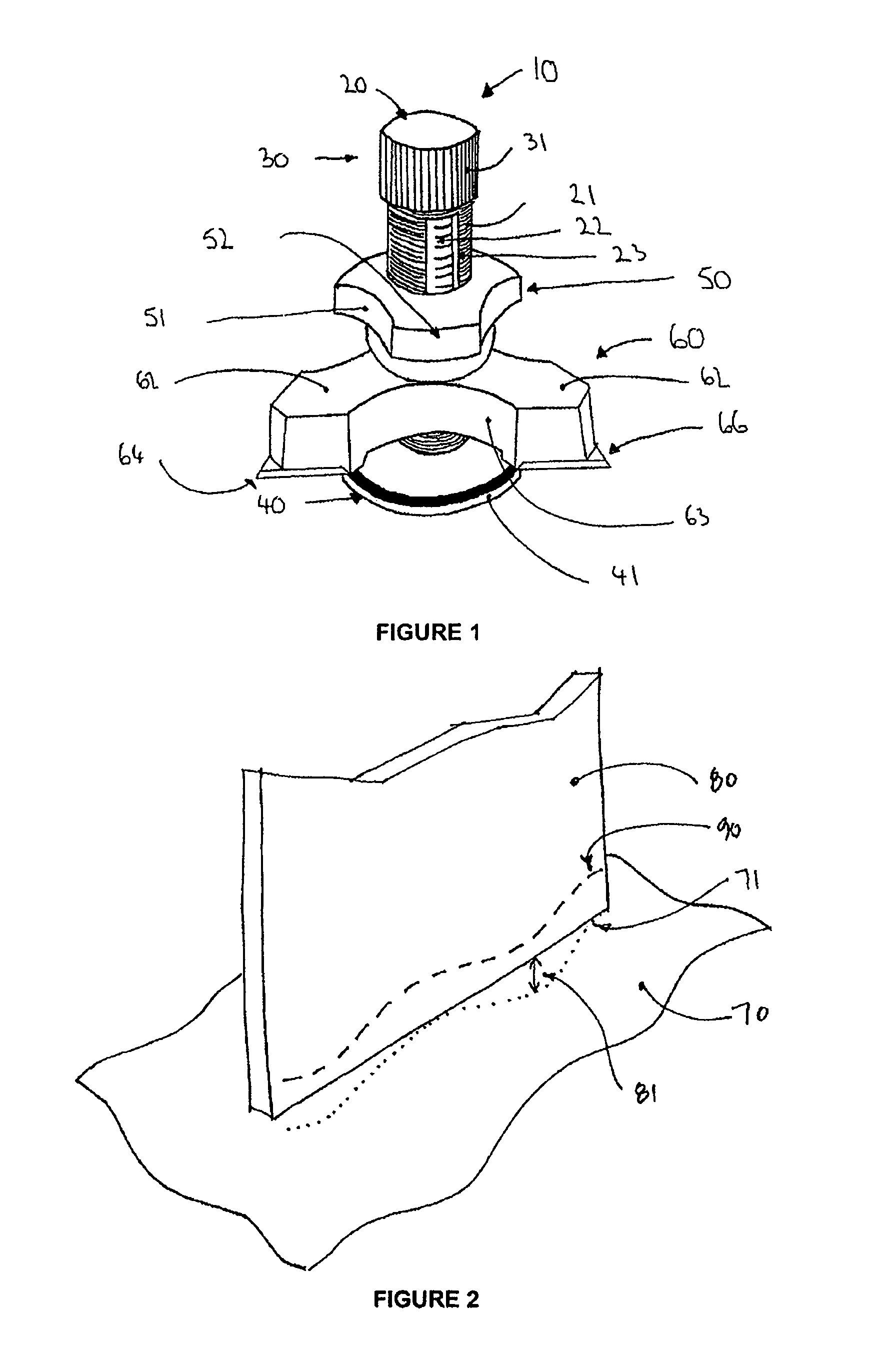There are a number of ways to transcribe a reference surface profile onto the target part of a cabinet for Instance, but these may be done on an ‘adhoc’ basis and there are currently few commercially available tools to do this.
However if the undulation are sharp angles or too high or deep, the skirting board needs to be trimmed to fit these undulations.
There are numerous problems with the above related art devices and methods including:1. If a pencil is used it may become blunt, therefore leaving a wide line to
cut to which leads to inaccuracy.
Further, with a pencil becoming blunt as the image is transcribed it may cause the line to change thickness and thus after the ability to trim to the correct part of the line.2. The packers are prone to move and slide in relation to one another particularly if there is more than one material being used Generally, movement of packers while marking prevents accurate transcribing of the reference surface to the
target surface.3. There are many
moving parts, for instance, a number of packers, a pen / pencil or knife blade & the use of two hands, leading to inaccuracy.4. Two hands are required to transcribe the profile.
It is difficult to get both hands moving together while holding different things together, especially due to differing frictions being caused by different pressures being applied by the two hands.5. If a pen or pencil is used, it is difficult to see the transcribed profile line on dark coloured surfaces, making the line hard to
cut to.6. When trimming the material to be fitted, dust lands on the target surface covering the pen / pencil line.
In wiping the dust off, accidental
rubbing off of the line can also occur.7. The separate nature of the multiple packers and pen / pencil means the installer may not be able to perfectly retrace the same path on the reference surface, so the profile must be transcribed correctly the first time it is attempted.8. Marking the profile becomes difficult when getting close to a corner due to its two handed use.9. The process may be unsafe, particularly when the user may be standing on a ladder to mark high vertical seen end panels for example, as it requires the use of both hands therefore not allowing the installer to use one hand to steady themselves on the ladder.10.
A further safety, issue arises when using a knife or blade to transcribe an image of the reference surface.
It can become and OH&S issue when using an exposed sharp blade in close proximity to the hand holding the packers.
This becomes dangerous when the hand holding the packers may stop due to the packers getting caught and stopping by way of catching onto imperfections on the reference surface.
Regarding the range of adjustment, an ability to transcribe a profile where the maximum gap between the reference surface and the edge of the target surface is less than about 25 millimeters is beneficial as this distance may be required depending on the reference surface and related art methods to date are not considered reliable for transcribing in such small separations.
It is considered that inaccuracy in the transcribed profile may occur partly as a result of the unwarranted pivoting of the marking point of related art devices relative to the reference surface during use.
Reference surfaces may have a damageable finish, such as paint, so they may be susceptible to undesirable marking or damage by related art transcribing devices.
A further drawback with this holding tool is that it requires the trim strip to be machined with a
tongue and groove shape due to the design of the holding tool.
The disclosed holding tool is not suitable for use with cabinetry units which do not utilise a machined
tongue and groove to
affix the trim strip to the cabinet.
U.S. Pat. No. 5,013,196, also to Friegang (Friegang II), has a number of drawbacks, particularly the complexity and subsequent cost of the device which may put it out of range of many potential users.
Also, this device may require a lengthy set-up and a high degree of skill to operate.
It may not be able to get into corners or close to floors or ceilings and thus may not be able to be used in a complete vertical action from the top of the filler strip to the bottom.
Because it includes a
power tool, use of this device entails inherent risks for the operator, and little tolerance for error exists due to the device's scribing and
cutting in one motion.
This leads to a risk that, if a deep trim is made, the tool may “bite” into the material being trimmed and causing irreparable damage.
The edge follower of the disclosed scribe is pointed in nature, and is thus unsuitable for use as a surface follower (i.e. a surface such as a floor, wall or ceiling surface).
It is considered this is due, firstly, to a tendency of the marking instrument to rotate about the tip of the pointed edge follower as disclosed which may make the profile line transcribed by this tool inaccurate.
Secondly, the edge follower may cause an undesirable mark if used as a reference surface follower.
The structure of the device, which requires the use of a separate pen or pencil, may also prevent it from being able to be adequately adjusted in circumstances in which a small
offset distance between the marking point and target surface are required.
However, it is considered the discrete adjustment by way of the progressively stepped nature of the possible height positioning of the scribing points of the disclosed tool means the user has limited ability to control the height of the scribing point, and may thus unnecessarily
waste material due to having to configure the device of MacDermid to a height that will generally exceed the offset height required.
Small offset distances approaching 0 mm may, also not be achievable with this device.
The MacDermid apparatus also suffers from the drawback that, when used in relation to a target surface that forms a corner either with itself, with other localised formations or with the reference surface, scribing right into an internal corner is not possible.
The MacDermid tool may not be able to scribe all the way into an internal corner.
Other shortcomings of this device include the risk of the user accidentally marking the target surface with the incorrect marking point which is at a different height to the marking point intended to be used.
Also, the method of setting the height of the marking point, which requires disassembly of the device, is
time consuming and may allow parts of the device to become misplaced.
The tool disclosed features a pointed surface following portion and thus may be susceptible to error due to rotation by the user.
This limited range of adjustability gives the tool a correspondingly large minimum material off
cut, making it inefficient.
The blade like shape of the following portion makes it particularly unstable in the plane normal to the target surface and thus the marking point is likely to
lift off the target surface during use.
The tool may not have the capability to reference off a wall, floor or ceiling and transcribe a line onto cabinetry.
Use of the pointed portion as disclosed could lead to inaccuracy for the reasons already identified with other prior art devices.
Use of the dual pointed follower portion may suffer from the same lack of stability of the blade-like follower disclosed by Nikander above.
The dual pointed portion of this disclosure has the potential to cause damage to a floor or wall surface if the disclosed tool were used to transcribe the profile of this type of reference surface.
The disclosed tool features a large minimum offset between the tracing point and the scribing point making it unsuitable for use with a small
offset distance approaching 0 mm.
This tool is used in scribing a circle or
ellipse onto a worksheet and is not suitable for transcribing a contour of a reference surface onto a target surface.
The apparatus disclosed is thus unsuitable for use in circumstances where the user requires at least one hand to maintain balance over the range of the action with the tool, i.e. when working upon a ladder or in a prone stance on the floor.
The pencil may easily lose its
sharp point and thus accuracy.
Also, being an individual component, the pencil may become separated from the device and misplaced.
The minimum
offset distance between the reference surface follower and the scribing point of the disclosed tool appears to be approximately 75-100 millimeters making this tool unsuitable for scribing for example a kick rail frame which may only be 75 millimeters high.
However the width of the prongs of this device may prevent the scribing point from marking the profile all the way into the corner of an internally cornered reference surface.
This may lead to inaccuracy as the transcribed line is not based on the reference surface where the target surface actually comes into contact with it.
The device has a
single point of contact with the reference surface and is thus unstable, permitting
angular rotation resulting in inaccuracy of the scribed line.
This tool may not be capable of scribing offset distances from 0 mm to approximately 3 mm, due to the reference surface follower design.
The disclosed device, having a large, fixed offset distance between the wall follower wheels and the scribe point, is not suitable for profile transcription related to
carpentry trades.
This may make the tool unsuitable for use in transcribing a surface profile onto target surface due to the unnecessary waste of material that would result as a consequence of not being able to adjust the distance between the tool's guide nub and scribing point.
U.S. Pat. No. 2,274,727 to Neiss (Neiss II) discloses a scribing and
cutting device having a surface following portion that has a small area bearing against the reference surface, making the tool susceptible to rotation and thus inaccuracy.
Further, the surface following portion, similar to other related art devices described herein, leads to
instability of the device.
The scribing point of the disclosed device is not able to be adjusted to be close to the reference surface, limiting the applicability of the tool.
The length requiring the use of two hands and number of
moving parts may lead to inaccuracy due to a lack of rigidity.
The range of adjustment of the scribing point is very limited and curved which means it may not be capable of contact with the target surface at a variable level, making the tool unsuitable for use in carpentry and cabinetry related applications.
Katsumi also lacks any facility for precision incremental adjustment.
The tool disclosed in GB2403924 is not capable of scribing small dimensions, for example, 25 mm or less.
The device also requires two hands to operate to keep it steady and, lacks stability, and therefore accuracy.
These include:1) Problems with scribing into a corner.2) Methods require the use of two hands, which prevents the user from having a free hand to assist with personal stability when in a
prone position or able to hold and stabilise materials being scribed.3) Inability to retrace a previously scribed line to make it more defined.4) Difficulties in visualising a scribed line on dark coloured materials.5) Dangerous methods used including the use of sharp exposed blades in close proximity to an unprotected hand.6) An unstable reference surface follower, which leads to inaccurate reference lines being scribed onto the target surface.7) Some methods damage the reference surface.
 Login to View More
Login to View More  Login to View More
Login to View More 


